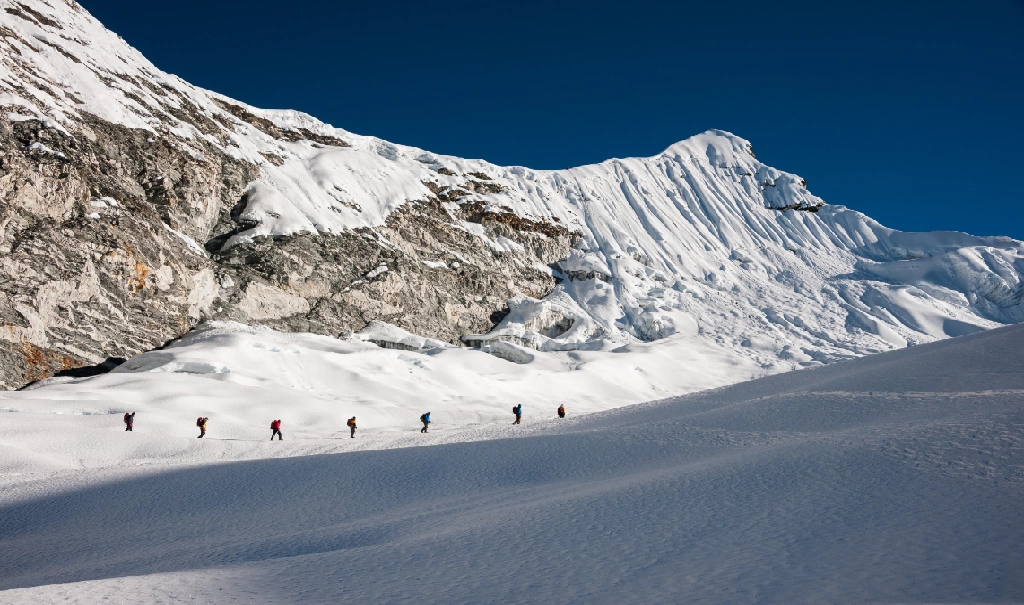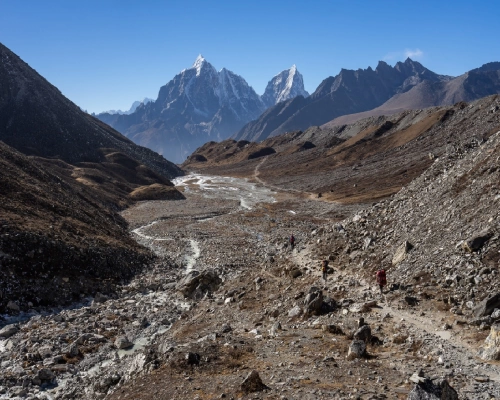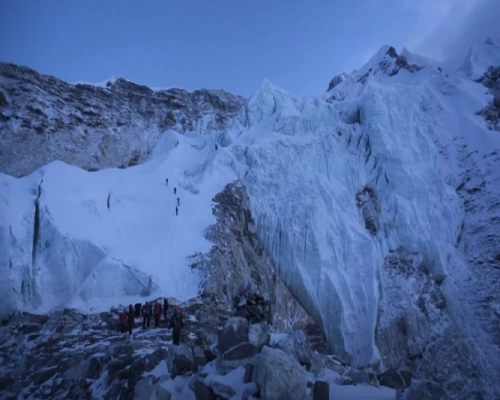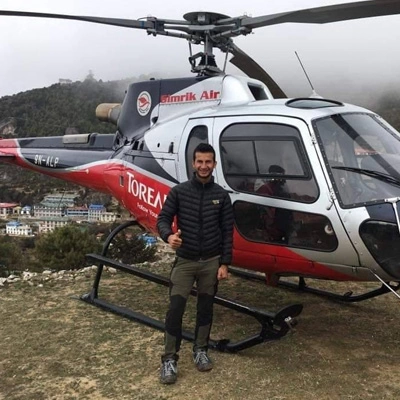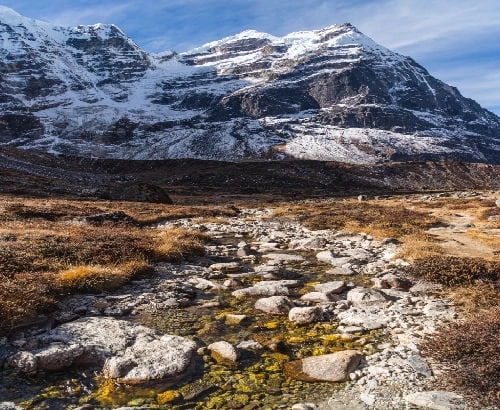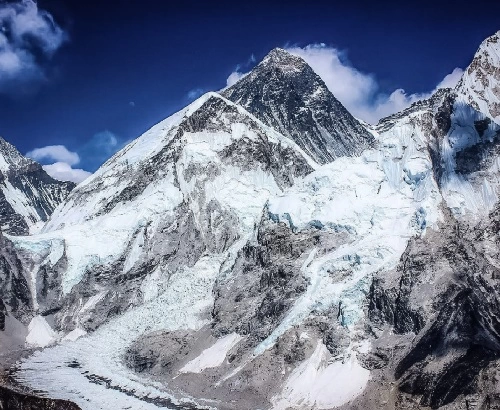"Island Peak Climbing Cost for 2025 and 2026 provides an advantage to begin your mountaineering journey affordably and confidently."
As an adventurous trekker seeking your next challenge, consider Island Peak climbing in the Himalayas. At 6189 meters, it presents a challenging yet rewarding climb for 13 days in the Everest Region.
One alternative you can combine with your Everest area hikes like EBC Trek, 3 High Passes Climbing, Gokyo Lake Trekking, or Mountaineering in the Khumbu region is Island Peak Climbing for 13 days. When you become a team participant in the Island (Imja Peak) climb with the local guide accompanying you and the climbing guide, all your efforts will be rewarded by your outstanding achievements and the summit conquest (6189 Metres Peak). Being one of the top summit-climbing expeditions and the best trek for mountaineering lovers, Island Peak Climbing of 13 days is also one of the best treks to take with the Everest Base Camp Trek.
Hiking and climbing are the best experiences in the Himalayas. In addition, Island Peak Climbing also provides the opportunity for hiking and climbing in the Himalayas. It takes just a single day or even 9-10 hours to reach the peak at 6189 metres in the sky and return to the base camp.
A trek from Lukla to Chhukung to Island Peak is one of the most cost-friendly, shortest and most thrilling options. This 13-day Island Peak Climbing Itinerary is suited for those beginner mountaineers who do have not much time to spare and those on a limited budget. The Island Peak is a good place to climb on the steeper peaks. The hikers often deposit their backpacks on these slopes and moraines and fight with the very cold weather just for the sake of getting an adventurous experience.
Island Peak climbing of 13 days involves rock, ice cliff, bridge climbing, and glacier valley crossing of the traverse. The top of the Island Peak will show you a view of mountains like Everest, Makalu, Lhotse and many others, along with the neighbouring valleys. If you love climbing and are the one to look forward to your adventure trips rather than reaching Everest base camp for trend, the climbing Island peak for 13 days is the best one to choose.
The crew members on your Island Peak climbing group will train you to use the climbing equipment on Island Peak Base Camp, allowing you to acclimate for a couple of hours before reaching the summit. The ascent will start as early as possible, so you will have to walk in the narrow ice gaps and the steep inclines while you take a rope for safety, which has been placed before. Although this could be done in a single day, it is as exhausting as running a half-marathon.
For your Everest Island Peak Climbing adventure you will need prior high-altitude trekking experience and climbing skills to attempt the summit. The Island Peak Climbing Itinerary begins with a flight to Lukla and a trek through idyllic Sherpa villages to Island Peak Base Camp. Acclimatise with day hikes before your summit push. You'll traverse glaciers, climb steep headwalls, and scramble over rocky ridges with fixed ropes. With the best Island Peak climbing, Map you summit the peak easily providing stunning views of Lhotse, Makalu, and Everest. With careful preparation and sherpa support, the climb will test your limits and create lifelong memories.
The climb to Island Peak typically takes 13 days, with 2 days of acclimatisation included in the itinerary you follow. You hike from Lukla to Chhukung and then to the Island Peak Base Camp. The following day, you start early for High Camp, climbing steep snow slopes to reach the peak at Summit Island Peak (6189m / 20305ft ).
If you are someone wanting to join the Group Island peak climbing, now is the time to book your trip in Autumn and Spring. Adventure Altitude treks offer Island peak climbing for 13 days at a budget and discount cost for 2025 and 2026. You will be accompanied by experienced local and climbing guides throughout the journey, lasting 13 days.
Major Highlights of Island Peak Climbing
- Trekking villages end up at Chhukung, a beautiful Sherpa village.
- Enjoy the Easy Booking process for Island peak climbing Cost 2025 and 2026 package
- Reach the peak of Island Peak at (6,189 metres/20,305 feet).
- Mountain views like Mount Everest, Nuptse, and Lhotse are in their best form in the autumn or spring seasons.
- Staying at tea houses and tents as we go along the trail.
- Relax and take in the beauty of the Himalayan nature while hiking from one alpine meadow to another.
- Enjoy a day tour of Namche Bazaar
- Reach the Everest View Hotel, the highest hotel located on your acclimation hike
- Scenic routes follow the road through forests and near rivers while also running next to snow-capped glaciers.
- A unique experience that lasts a lifetime for a climber.
- Board a Lukla flight giving you an exciting start ahead of Island Peak Climbing.
Benefits of the 13-day Island Peak Climbing Package
- Some of the benefits you enjoy on your island peak climbing 13-day package are as follows.
- Support of experienced guides until you reach base camp and a Climbing guide up to the Peak.
- Discount cost available for island Peak climbing in a group.
- Easy booking process for island peak climbing costs 2025, and 2026.
- The 13-day island peak package is available to book in the autumn and spring.
- Adventure Altitude Treks Trek Duffle Bag provided
- Free Island Peak Climbing Route Map includes a specially crafted itinerary with 2 acclimatisation days.
- An Oximeter is provided to Check Blood Oxygen Saturation Levels.
- Medical Kits included, which may be necessary in certain cases
Where is Island Peak Located?
Island Peak, also known as Imja Tse, is located in Sagarmatha National Park in Nepal within the Himalayas mountain range. More specifically, it is situated at the end of the Lhotse-Nuptse ridge, approximately 13 miles south of Mount Everest. With Island Peak Climbing, trekkers follow the popular Everest Base Camp trekking route before diverting at Dingboche to the east. The peak was named "Island Peak" in 1951 by a climbing team composed of British mountaineers due to its striking location amidst a sea of ice when viewed from Dingboche. For Island Peak Climbing, you must first trek to the village of Chukkung, a 4-5 day trek from Lukla. It takes one day from Chulkung to reach Island Peak Base Camp.
Island Peak Climbing Summit Day
On Island Peak Climbing summit day, you climb around 1 am using crampons and an ice axe to ascend a 35- to 40-degree slope. Fixed ropes assist in raising the steeper sections. The climb takes six to eight hours to reach the 20,305-foot summit. At the top, you are rewarded with panoramic views of Makalu, Lhotse, and Ama Dablam mountains.
Island Peak Climbing descent in the Everest region takes around three hours, returning first to High Camp to rest before descending to Base Camp. The climb requires previous mountaineering experience, given the technical nature of the upper route and the use of crampons and ice axes.
Glaciers Surrounding the Island Peak
Three main glaciers surround Island Peak: the Imja Glacier, the Lhotse Glacier, and the Khumbu Glacier. Island Peak Climbing takes you to the area where the Imja and Lhotse Glaciers flow south from the peak, while the Khumbu Glacier flows to the west. These glaciers, combined with Island Peak's conical shape and isolated position, make it a spectacular sight along the trekking route to Everest Base Camp.
Can a Beginner climb Island Peak?
Yes, a beginner can climb the Island peak climbing. If you're an avid trekker looking to progress into mountaineering, Island Peak (Imja Tse) is a great first Himalayan peak to summit. At 6,189 meters, it provides an accessible challenge with stunning views. However, as with any high-altitude climb, adequate preparation and training are essential.
Physical Fitness Required a Beginner
For Island Peak Climbing, you should be in excellent physical condition. Focus on cardio exercises like running, swimming, or biking, as well as strength training targeting your legs, core, and back. Increase your intensity over time to build endurance. In the months before your climb, start training with a pack to get accustomed to carrying weight. These fitness regimens will prepare you for the strenuous treks required to reach base camp and the demands of summit day.
Technical Skills For Beginners to Learn
While Island Peak climbing is considered a trekking peak, it still requires basic mountaineering skills. You should learn to properly use an ice axe, crampons, harness, and ascender before climbing. Your guide will teach you rope skills for the glacier crossing and summit ridge, but having a foundation will give you more confidence. You'll also need to be comfortable walking on snow and ice for extended periods. Practise these techniques before arriving in Nepal.
High Altitude Experience Required for Beginner
The most challenging part of Island Peak Climbing for 13 days is the high altitude. Base camp is at 5,087 metres, so you must be able to acclimate to avoid altitude sickness. Having experience climbing other peaks around 4,000 to 6,000 metres is ideal preparation. However, first-time climbers can summit Island Peak with a properly designed itinerary that allows for gradual ascent, adequate rest, and acclimatisation days. Listen to your body during the climb and descend immediately if you show symptoms of altitude sickness.
Island Peak Climbing Cost for 2025, and 2026
The 13-day Island peak Climbing cost for 2025, and 2026 starts at a discount ranging from $ 2892 to $1999 per person, depending upon the group sizes.
Adventure Altitude Treks also conducts Island Peak Climbing trips in different price ranges according to the group size.
The Climbing of Island Peak cost varies depending on the clients. If you ask about the cost and discounts on the Island Peak Climbing, you will find different price options based on the travel agency and its services. Please refer to the following information for the Island Peak Climbing Cost Trek for spring and autumn based on group size.
Pax | Cost Per Person | Inquiry |
1 - 1 | $ 2289 | Send Inquiry, Contact Us |
2-2 | $ 2255 | Send Inquiry, Contact Us |
3-5 | $ 2198 | Send Inquiry, Contact Us |
6-10 | $ 2099 | Send Inquiry, Contact Us |
